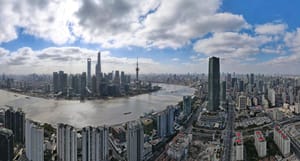By Ryan Yeh
For years, Western narratives about China's economy have often swung between extremes — "China threat" or "China collapse." This dichotomy usually stems from a fundamental disconnect: evaluating China's unique, long-term, people-centered economic model through the narrow lens of Western shareholder capitalism.
In reality, from its post-reform "economic miracle" to its pursuit of "high-quality development," China operates on a unique "Master Blueprint." This blueprint prioritizes the well-being of its 1.4 billion people, leverages holistic governance, and harnesses the strategic advantages of a continent-sized economy. To grasp the resilience and trajectory of China’s economy, one must understand this framework, which transcends the fragmented, short-term, and zero-sum thinking prevalent elsewhere.
The Holistic View: A National Strategy Across Space, Time, and Actors
One of China's core economic strengths lies in systemic coordination—not rigid central planning, but dynamic integration of resources, regions, and timelines across a vast nation.
Spatial Coordination – The National Chessboard
While China’s regional disparities are often noted, less understood is its deliberate "phased development" strategy. From establishing Special Economic Zones like Shenzhen to ignite the Pearl River Delta, to the "Western Development Strategy" redirecting growth inland, to today’s Guangdong-Hong Kong-Macao Greater Bay Area (GBA) and the Chengdu-Chongqing economic circle, China cultivates equilibrium through controlled imbalance. This creates a resilient network: local governments compete to attract investment, while central oversight (through strategic planning and fiscal transfers) prevents localized risks (like a downturn in a specific city or industry). Coastal manufacturing pressures, for instance, are buffered by inland relocation opportunities and a high-speed rail network that efficiently redistributes labor and goods.
Temporal Continuity – The Long Game
Unlike Western policy swings tied to election cycles, China’s Five-Year Plans provide strategic consistency. These are not static commands but evolving blueprints pursued with dedication. Consider China's high-speed rail network: from blueprint to over 45,000 km of track linking major cities in less than two decades, driven by sequential Five-Year Plans. Similarly, proactive investment in 5G networks, AI hubs, and data centers aims to secure digital competitiveness for decades. This "planting trees for future generations" ethos or strategic patience makes China navigate global supply chain shifts and tech revolutions.
Synergistic Governance – State, Market, and Society
China's model isn't merely a "strong state"; it’s an evolving experiment in aligning public and private forces. The government acts as a referee, a strategic architect, and a provider of public goods. The electric vehicle (EV) industry exemplifies this: early subsidies and licensing spurred market dynamism; companies like BYD and NIO rapidly innovated amid competition. Simultaneously, the state invested in charging infrastructure, addressing consumer hesitancy. This collaborative model — where the government sets the stage, businesses innovate, and society reaps benefits (cleaner energy, jobs) — has propelled China to global leadership in the EV industry and underscores its institutional resilience.
The People's Ledger: Welfare Over Wall Street
China’s blueprint measures success not just by GDP, but by people’s well-being—a "people-centered" divergence from profit-driven logic.
Shared Development – Investing in Human Capital
Despite economic headwinds, China prioritizes public welfare. Steadily rising subsidies for basic medical insurance and basic pensions, large-scale construction of affordable housing, and the historic eradication of absolute poverty are tangible outcomes. This "social reinvestment" philosophy—"government tightens its belt so people thrive"—builds human capital through education and healthcare, fueling long-term growth.
Domestic Demand – A Vibrant Engine

A burgeoning middle class and cultural confidence ("Guochao" brands in fashion, cars, and cosmetics) are powering a consumer revolution. Holiday travel booms (Harbin’s ice festival, cities competing for tourists) and growth in service retail (smart homes, wellness) reveal a domestic market capable of cushioning external shocks. The "dual circulation" strategy—domestic focus with global integration—creates a virtuous cycle: innovation leads to jobs, jobs raise incomes, and higher incomes drive consumption.
Prudent Risk Management – Stability First
On property sector risks and local debt, China opts for gradual deflation over shock therapy. For developer defaults, policies ensure housing delivery and social stability via targeted lending. Local debt is being restructured through ultra-long treasury bonds and fiscal discipline. This "slow puncture" approach respects systemic risks while seeking soft landings—solutions within development.
Governance Lessons for Large-Scale Economies
China's economic development offers valuable governance insights, particularly for other large-scale nations, whether developed or developing.
Strategic Patience & Dynamic Adaptation
China's growth moderation is an intentional "L-shaped transition" toward higher quality over quantity — short-term pain for structural upgrading. As economist Justin Yifu Lin notes, industrial policies must evolve with development stages. China adapts East Asian lessons while dodging Latin America’s "middle-income trap".
Innovation-Driven Ecosystem
Amid a complex global environment and tech restrictions, China prioritizes"technological self-reliance". 2024 saw record R&D spending, with increased focus on basic research. China is achieving a historic leap forward in strategic emerging sectors encompassing new energy, AI, bio-manufacturing, and commercial spaceflight, transitioning from technological follower to global peer competitor, while establishing leadership in pivotal sub-fields. Its "dual circulation" strategy—indigenous innovation plus global cooperation—is reshaping competitiveness.
Institutional Strengths – Asymmetric Advantages
China’s ability to mobilize resources—COVID medical supplies, renewable energy rollout—is an "asymmetric advantage." As Center for Strategic and International Studies (CSIS) acknowledges, China's national coordination capability in strategic industries is difficult for more decentralized Western systems to replicate.
Seeing the Real Picture Beyond the Myths
Western misreadings of the Chinese economy often arise from applying specific filters: mistaking localized problems (e.g., a company's debt) for systemic failure; letting quarterly fluctuations obscure long-term trends; and judging China by Western models (like free-market fundamentalism).
To truly understand China's economy requires looking beyond these filters and recognizing that:
· It is a vastly complex system encompassing 1.4 billion people, a comprehensive industrial base, extensive infrastructure, and burgeoning innovation – it defies simplistic generalizations.
· Its development is guided by a long-term strategic vision, with the continuity of Five-Year Plans and national strategies providing stability against short-term noise.
· Its governance calculus increasingly weighs social well-being, common prosperity, and sustainability over pure profit.
As Martin Wolf of the Financial Times observes, understanding China requires grasping the internal logic of a civilization-state. China's 'Master Blueprint' is the economic expression of that logic, blending traditional governance wisdom with modern, people-centered innovations. In an era of global uncertainty, this blueprint not only navigates China's own path to modernization but also offers the world profound insights into achieving more inclusive and sustainable development beyond the confines of conventional capitalist thinking. Reading it correctly is key to truly gauging the pulse of China's economy and anticipating its future direction.
Ryan Yeh is an observer of international affairs. The views don't necessarily reflect those of BeijingReviewDossier.








